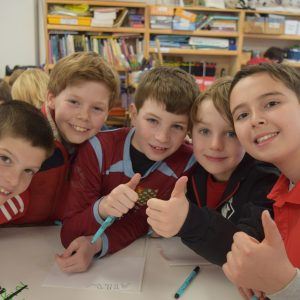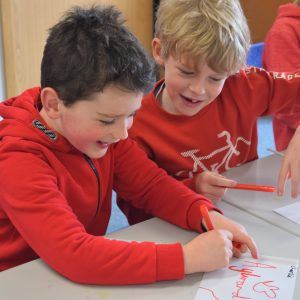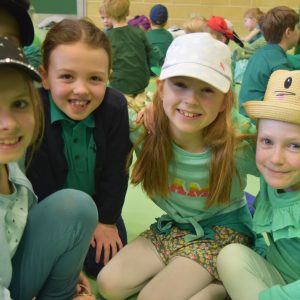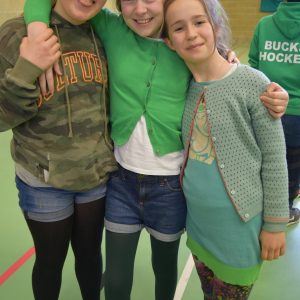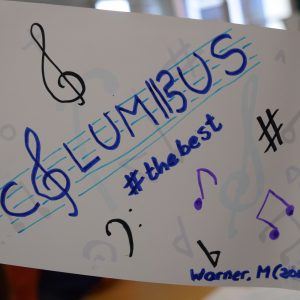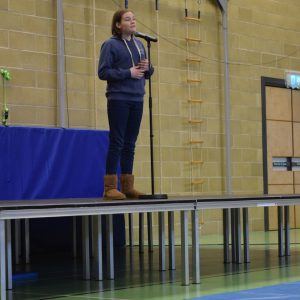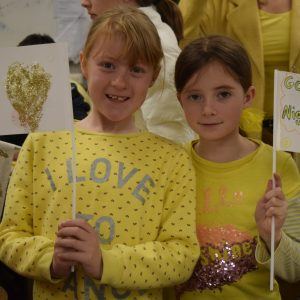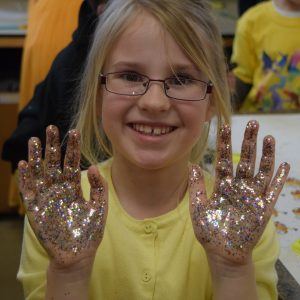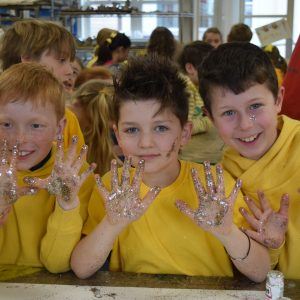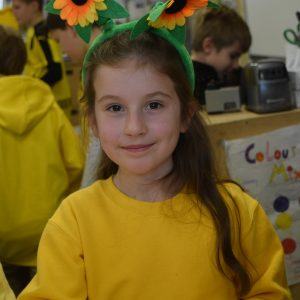From Reception the children are allocated to one of the four school Houses (Aylward, Attenborough, Nightingale, Stevenson) where they will be part of a group of 90 pupils from across the year groups ranging in age from 4 to 11.
Whilst we do not use a “Sorting Hat” to decide the to which House a child will belong, care is taken to ensure that there is a balance across year groups.
The choice of the House names was made by the school’s Founder, Mrs Christina Adlington, who selected individuals who possessed strengths, abilities, gifts and talents that would serve as shining examples to future generations of children. In 2024, listening to the pupil’s voice, a new name was chosen to replace the original Columbus. After a pupil vote the runaway winner was Attenborough after Sir David Attenborough.
Rivalry between the four Houses is healthily competitive, and centers around the rewards system for House points (Merits and Credits) with fortnightly updates and tallies being met with appropriate joy or despair, depending on how each House has performed over that period!
Each House supports a different charity:
Aylward – Hope for Children
Attenborough – Sunnyside Rural Trust
Nightingale – Lindengate
Stevenson – DENS
There are also Inter-House competitions for Rugby, Football, Netball, Hockey, Athletics, Cross-Country and Swimming.
Aylward
Gladys Aylward was born in Edmonton in North London in 1904. While she was working as a parlour maid she attended a revival meeting at her church. She was inspired by the preacher and became convinced that God was calling for her to be a missionary in China. When she was 26 she trained to be a missionary in London but she failed the exams.Gladys was just a parlour maid without much education on very low wages. However Gladys worked hard and saved all she could. Then she heard about a missionary in China called Mrs Jeannie Dawson who was 73 and was looking for someone younger to carry on her work.
Gladys wrote to her and was told that she was accepted as long as she could get to China. She didn’t have enough money to go by ship so she decided to go by train which was much cheaper but was a longer and more dangerous journey because China and the Soviet Union were at war. She continued to save every penny she could. Eventually she had enough money. Gladys had enormous faith and courage and as she sat on the railway station waiting for the train in October 1930 with only her passport, her Bible, her tickets and two pound & ninepence she said:
“Here’s my Bible, here’s my ticket, her am I, use me Lord”
After many months of dangers and adventures she arrived at Yangcheng, a Chinese city in the mountains just south of Peking (Beijing). The local people had never seen any Europeans before except Mrs. Lawson and they distrusted them and certainly didn’t want to listen to them. It was going to be difficult to be a missionary here. Gladys persuaded Mrs. Lawson to open her house as an inn for muleteers as it was on a trading route. They provided good food and warm beds. Moreover in the evenings Gladys told the men stories about Jesus. It became a popular place to stop. Gladys practised her Chinese and became fluent. Some people became Christians.
She gradually became respected and well known. The Mandarin of came to hear of her and asked her to be a foot inspector and to help put a stop to the practice of footbinding. For many years the feet of wealthy women had been bound from infancy to prevent them from growing. So it was that women had tiny deformed feet on which they could only walk with slow teetering steps. This was thought to be extremely graceful. Gladys was chosen to unbind the feet in accordance of the new Government ruling.
This gave her yet another opportunity to speak to people about Jesus and spread the Gospel.
A year later the Mandarin summoned Gladys again. A riot had broken out in the men’s prison. The soldiers were afraid to stop it. The Mandarin of Yangcheng told Gladys to go in the prison and stop the rioting. Gladys managed to stop the riot and talk to the prisoners. She found out what was the cause of the riot and set in place a series of reforms.
The people began to call her ‘Ai-weh-deh’ which means ‘virtuous one.’
Then war came in Spring 1938. The Japanese bombed Yangcheng, killing many people. Gladys was caring for about 100 frightened orphaned children. She was determined to taken them to safety in Xi’an so she led them over the mountains and over the Yellow River. It took 12 long, hungry, dangerous and difficult days. When they finally arrived she collapsed with typhus fever.
When she recovered she started a Christian Church in Xi’an and worked in a leper settlement near the Tibetan border.
Alan Burgess wrote a book about her called the Small Woman and there is a film starring Ingrid Bergman called “The Inn of the Sixth Happiness” about her life.
Gladys was a remarkable woman. She was determined and had remarkable faith. It is amazing to think that a poorly educated parlour maid rejected by a missionary society because she failed the exams could become a widely respected heroic missionary in China and couldn’t touch and transform so many lives.
Attenborough
Nightingale
Florence Nightingale was born to wealthy well connected parents in 1820 in Florence, Italy. She was named after the city of her birth. Girls from such a background were expected to learn to read, sew, play the piano, wear beautiful dresses, go to sumptious parties and then marry well and become obedient wives and good mothers.
Florence was a kind, gentle child and spent many happy hours enjoying nature and bandaging her dolls. Her first living patient was a shepherd’s dog. From tending animals she passed to human beings and wherever there was sorrow or suffering Florence was there. From the beginning Florence displayed a serious caring nature and she showed no interest in the superficial pastimes she was expected to enjoy. She had an ardent desire to use her talents to help people.
Florence was serious and studious and felt that she was called by God to be a nurse. Her parents were horrified as nurses in those days had a poor reputation. She visited a new hospital in Kaiserwerth, Germany which was run by Lutheran deaconesses. She was greatly impressed by the quality of medical care and by the work, professionalism and commitment of these people. She trained there for 4 months despite strenuous family objection. It was here that her spiritual experiences deepened her commitment to nursing.
To her mother’s dismay she rejected a chance of marriage to a politician and poet called Richard Monkton Niles because she was convinced that marriage would interfere with her calling to nursing. She later met Sidney Herbert, a brilliant politician who was Secretary of War. He became a firm friend and was instrumental in facilitating her pioneering work in the Crimea. Reports were filtering back to England about the horrific conditions endured by the wounded soldiers in the Crimea.
On Oct 21st 1854 she and 38 women volunteer nurses trained by Florence Nightingale herself were sent to Scutari near Istanbul. The conditions she found were appalling. Wounded soldiers were badly cared for by overworked medical staff in filthy overcrowded conditions. There were few medicines and no equipment to make food for the patients. Mass infections were common and more soldiers were dying of typhus, typhoid, cholera and dysentery than from battle wounds.
Florence Nightingale and her team began by thoroughly cleaning the hospital and equipment and reorganising patient care. The story of Florence Nightingale’s work at Scutari is one of the brightest pages in the annals of British history. She gave her body and soul to her work. She would stand for 24 hours at a stretch to see the wounded accommodated. She regularly took her part in the operating rooms to hearten the sufferers with her presence and sympathy.
At night she would walk round all the wards, lamp in hand, stopping here and there to speak kindly to the patients. The soldiers loved her and she became known as the Lady with the Lamp. She worked so hard that she became ill but remained in Scutari until July 1856 when the battles were over. There was great enthusiasm and pride in England for her work and a Man-of-War was ordered to bring her home.
London was ready to give her a triumphant reception. However she returned quietly in a French ship and escaped to her country home before news of her return leaked out. The experiences of those hard, terrible months permanently affected her health. However she continued to work. She led a quiet but very useful life.
She founded the Nightingale Home for training nurses at St. Thomas and King’s College Hospitals. She worked tirelessly to improve army hospitals. In 1858 she published her Notes on Nursing in which she backed up all her ideas with detailed statistical reports. This book became the cornerstone of the curriculum at the Nightingale school and othersubsequent hospitals.
She spent the rest of her life promoting the establishment and development of the nursing profession and organising it into its modern form. By 1882 the Nightingale nurses had a growing and influential presence and Florence had become matron of several leading hospitals. In 1883 she was awarded the Royal Red Cross by Queen Victoria and became the first women to be awarded the Order of Merit.
She died on August 13th 1910. An offer of burial in Westminster Abbey was declined by her relatives and she was buried quietly in the graveyard at St. Margaret’s Church in East Wellow. Florence Nightingale’s lasting contribution has been her role in founding the nursing profession.
She set a shining example for nurses everywhere of compassion, commitment to patient care and diligent, sensible and thoughtful hospital administration. She was a girl from a wealthy privileged background who was inspired by God to love and care for people in need. She was brave enough to defy the expectation of her parents, family and background to pursue relentlessly what she knew to be right.
Stevenson
Robert Louis Stevenson was born in Edinburgh on 13th November 1805. From the beginning he was sickly and throughout much of his childhood he was looked after by his faithful nurse, Alison Cunningham, known as Cummy. She read him morbid stories about Scottish history, Bible stories and the psalms and drilled the catechism into him. All this was with his parents’ approval. His parents doted on their only child.
Robert began writing early – ‘A History of Moses’ and ‘The Book of Joseph.’ When he was only 16, he wrote a pamphlet about Scottish history called the Pentland Rising which was published.
Then in line with his father’s wishes he went to Edinburgh University to study engineering. It was at University that Robert Louis Stevenson first began to rebel against his strict religious middle class background. He became rather bohemian and wore a wide-brimmed hat, a cravat and a strange velvet jacket and frequented the drink houses of the old town. He then told his father the he didn’t want to study engineering but that he wanted to be a writer.
His father was very disappointed and later horrified to discover that his only son was an atheist. Thomas Stevenson then insisted his son study the law. He did and duly qualified but it was a degree he hardly used.
Stevenson then went off travelling in France, a place he loved. He wrote the following works, ‘An Inland Voyage’ and ‘Travels with a Donkey in the Cevennes’ while in France.
He joined up with a bohemian set of artists in Paris. He was 27 and it was here he fell in love. Fanny Osbourne was not what his parents wanted for their son. She was 10 years older than him, a married mother with 3 children and a she came from the American Wild West. When Fanny suddenly returned to her husband, Mr Osbourne Stevenson followed her to California. Stevenson became extremely ill and Fanny divorced her husband and agreed to marry him.
Two years later he brought her back to Scotland where Fanny Stevenson was, rather surprisingly, soon accepted and loved by Stevenson’s parents.
During the next 5 years Stevenson’s health continued to be a problem but this did not stop him writing. In fact, this was one of the few things he could do when he was confined to bed.
The inspiration for Treasure Island happened on holiday in Scotland. He drew a map to entertain Lloyd Osborne, his 12 year old stepson. Stevenson imagined a pirate adventure story to go with the map. The story was Treasure Island.
To start with Treasure Island was serialised for a boys magazine. This book was to become famous, with Long John Silver, pirates singing ‘Yo ho ho and a bottle of rum’ and parrots squawking ‘pieces of eight,’ captured the imaginations of the times and by the end of the 1880s it had become the most popular book of the day and was immediately hailed a classic.
This book made him famous. He then wrote Kidnapped and his tale of Jekyll and Hyde. Stevenson celebrated his success with a cruise of the Pacific.
He went with his wife, his stepson and his mother and he soon found the climate suited his health. Despite his homesickness he knew that his health could never stand a return to Scotland. He wrote, ‘I shall never set my foot again upon the heather. Here I am until I die, and here I will be buried.’
He continued to write up until he died of a stroke on the 3rd December 1894 in his house in Samoa. He was only 44. Robert Louis Stevenson was a strange man from a strict and solid upbringing who dreamed up the most amazing and memorable stories. He said that the best storytelling should have the ability to whisk readers away from themselves and their circumstances. Stevenson indeed has this gift and his poems and stories have been enjoyed by adults and children ever since. What is also so remarkable and laudable was that he did all this often when he was ill – an inspiration for us all to write well and to persevere in the face of difficulties.


